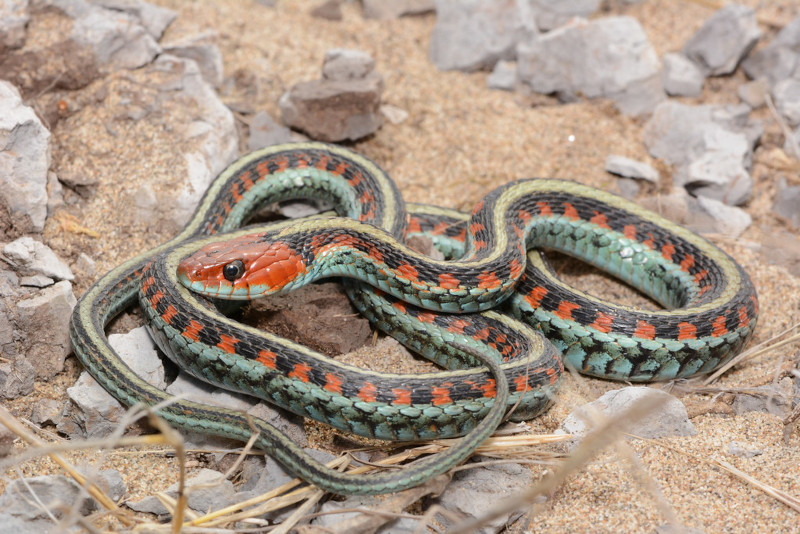California red-sided garter snake Facts
- This dazzling work of Nature and evolution bears the long-winded common term of the California red-sided garter snake. Sadly, however, its scientific name isn’t any easier to pronounce. That’s because researchers know it as the Thamnophis sirtalis infernalis.
- By either name, though, it’s a beautiful variety of reptile. It also represents a subspecies of the common garter snake. This marvel of evolution further forms one of three currently recognized subpsecies of the parent species found in its specific part of world.
- The colorful snake received its formal name due to the work of the renowned French zoologist and anatomist, Henri Marie Ducrotay de Blainville. This respected researcher gave the snake its first formal recognition as a distinct species in the year 1835.
- Presently, the IUCN does not have any listing for the species on the organization’s Red List of Threatened Species. The country in which its habitat range lies, however, does have a listing for it. In that country, the unique creature lists as Endangered.
- That’s partly due to the fact that the population of the California red-sided garter snake appears to be diminishing. Other factors also contribute to its status, though. That’s because the dual threats of habitat loss and climate change also now endanger it.
Related Articles
California red-sided garter snake Physical Description
Though the fabulous Californis red-sided garter snake fully merits appreciation, it doesn’t do so based on sheer physical size. That’s because it only ranks as an average-sized variety of garter snake. But it easily makes up for that in its very impressive visual appeal.
Like the other red-sided garter snakes known to science, it also shows a marked degree of the physiological trait of sexual dimorphism. In its case, though, this manifests in terms of pure physical size. Due to this trait, females average about 30% larger than males.
Overall, adults attain widely varied lengths, which isn’t unknown among snakes. In the instance of this specific reptile, this typically measures from 18 – 55 in (46 – 140 cm). The overall average, however, only equals roughly 36 in (96 cm). In fact, some remain smaller.
Interestingly, the head of the snake remains small. In point of fact, the head barely measures wider than the body itself. The eyes, meanwhile, attain a larger than average size, when compared to other garter snake varieties. This provides it with a distinct appearance.
It’s the coloring of the California red-sided garter snake that stand out the most, however. The generalbackgroun appears as a black to dark olive in color. It has a wide dorsal stripe, with a bluish to yellowish color. Somewhat blurred stripes also appear along the sides.
The bright red bars, however, manifested along the sides of the animal garner the most notice, serving as the source of the name. The head of the snake, meanwhile, appears as either orangish or red. The underside, though, appears a blue-gray, with dark patterns.
- Kingdom: Animalia
- Phylum: Chordata
- Class: Reptilia
- Order: Squamata
- Family: Colubridae
- Genus: Thamnophis
- Species: T. sirtalis
- Subspecies: T. s. infernalis
California red-sided garter snake Distribution and Ecology
The marvelous California red-sided garter snake possesses and extremely limited and restricted zone of habitation. Research further indicates that its range never extended beyond the approximate area it occupies now. It also shares that range with a related species.
More precisely, as the name itself implies, the reptile evolved as native to a specific part of the world. That’s the state of California, in the United States. Even there, though, its population concentrations seem to remain widely scattered across several parts of the state.
Fortunately, though, throughout this precise portion of North America, the animal appears to be highly versatile in its habitat requirements. In fact, it appears in a wide range of ecosystems. This provides it with a distinct advantage over less versatile species, of course.
Specifically, the beautiful reptile typically makes its home in regions including grasslands, forests, mixed woodlands, and chaparral. In these areas, it most frequently makes its home either beside or at least in the general vicintiy of streams, marshes, or ponds.
The California red-sided garter snake conducts most of its activity during periods of daylight. It’s also an excellent swimmers. This, in fact, leads to one of its chief means of defense. If threatened, the generally peaceful snake retreats into the water when possible.
Its bite is harmless to most humans. Generally, it only bites if handled directly. When this occurs, it typically results in no more than mild discomfort at the site of the bite itself. Its prey consists of a wide variety of small creatures, such as frogs, fish, and worms.
Species Sharing Its Range
Check out our other articles on 5 Splendid North American Spiders, Nicobar Pigeon, Victoria Falls, Mandrinette, Ring Tailed Cat, Kerengga ant-like jumper, Wood Frog, Rainbow Snake

